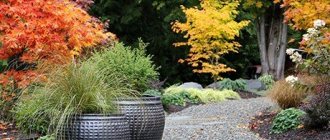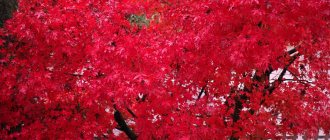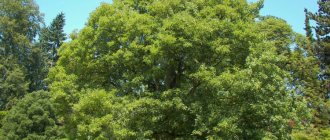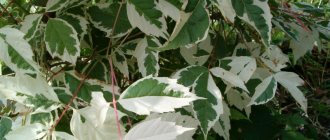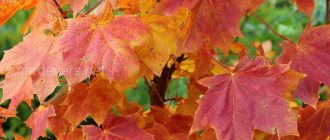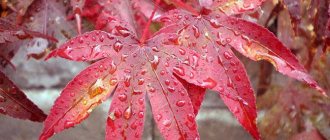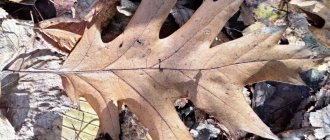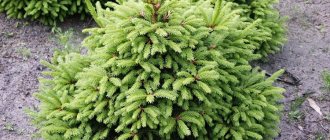An unpretentious plant with different foliage colors and crown shapes: the variety of maple varieties can turn your site into a fairy-tale kingdom of bright accents and star-shaped leaves. Almost all varieties are undemanding to the soil, are drought-resistant and will easily survive stagnant water after spring floods. Maple can be either a tree or a shrub. Have a narrow pyramidal or spherical crown shape. This is why maple is so widely used in landscape design: it is an excellent tapeworm and a wonderful neighbor in an accent landscape composition.
It is worth noting that most maples are especially decorative in spring or autumn, and in summer their foliage acquires classic green shades, standing out from other trees and shrubs only in the shape of the crown and leaves. However, there are specimens that, even in summer, are able to attract glances, make you fall in love with them, and be the center of attention until late autumn.
Maple varieties with red leaf color
Pay attention to the Norway maple Crimson Sentry
notable not only for its pyramidal crown shape, but also for its deep burgundy foliage throughout the season, growing up to 8 meters. It is a light-loving tree, but it will grow quite comfortably in light partial shade. Crimson Sentry has excellent winter hardiness. Quite often used for planting in alleys and as a contrasting element in landscape compositions.
An interesting alternative to the previous crimson beauty - Norway maple Crimson King
. Reaches 15 meters in height and has a classic neat crown shape. The true "Purple King" will be the "star" of any tree and shrub composition due to its dark red foliage with a purple tint and spreading branches. Winters well in the middle zone. As a rule, Crimson King is planted in parks, alleys and large gardens.
Another red-feathered giant worthy of attention is the Royal Red Norway maple.
, winters well in the middle zone. Five and sometimes seven-lobed leaves, reaching a diameter of 20 centimeters, have a bright red color in the spring, which becomes more saturated, purple by mid-summer and brightens in autumn. Royal Red can grow up to fifteen meters in height and almost ten meters in diameter. Annual growth is up to 40 cm. The crown is unevenly dense and broadly pyramidal. This variety of maple will become a spectacular tapeworm on your site.
Maple family
Maple (lat. Acer - “sharp”) is a genus of woody and shrub plants, belongs to the Sapindaceae family. About 150 species are known, many of which are cultivated and are widely used in landscape gardening. Distributed throughout Europe, Asia and North America.
Maple trees vary in size from dense shrubs to powerful trees with different types of crowns. The shape and color of the leaves is amazing. The plant can change its color 3 times, in spring, summer and autumn, or it can remain unchanged throughout the entire season. Sometimes the shade even differs on both sides of the leaf blade. Such a beautiful ornamental plant rightfully attracts the interest of landscape architects and amateur gardeners.
We can distinguish the main types that are most often used in the design and landscaping of garden plots.
Varieties of maple with variegated foliage
Growing no more than three meters in height, field maple Carnival
will add lightness and sophistication to your garden landscape. Delicate greenish leaves have an unusual milky cream edging. Even sometimes the light color dominates and from a distance it seems as if the tree has a white crown. When the wind sways the leaves, greenish shades appear a little more and the landscape comes to life before our eyes. Low and slow-growing, this maple will add zest to any landscape composition.
Norway maple Drummondii
It can grow up to 12 meters in height and has a dense, wide-pyramidal crown. Like Carnival, this variety is notable for its incredibly beautiful variegated foliage. An uneven whitish stripe borders the light green large leaves of the Drummondi maple. Its young leaves have a delicate pinkish color. This maple will be a worthy backdrop for plants with dark green or red foliage. It has good winter hardiness, but is very sensitive to soil drying out.
The Flamingo ash maple
is attractive not only for its unusual leaf color, but also for its shape.
. Growing up to five meters, it will look great both in a single planting and in a mixed composition. It was not by chance that this maple was called ash-leaved, because the shape of some leaves is, indeed, like that of an ash tree. However, for the most part, the foliage is five or seven-lobed, no more than 20 centimeters in length, and white-green in color. Young leaves have a pleasant pinkish tint, which is why this variety got the name Flamingo. This maple is considered fast-growing, giving growth of up to 50 centimeters per year. Winter hardiness is good.
Collecting and planting seeds
Japanese maple reproduces by seeds, which are collected in October. They are stratified in preparation for planting. Then they are laid out in sandy, dry soil and stored in a cool room.
In early spring, planting material is treated with a growth stimulator and sown in special containers
. Over the summer, the seedlings grow well, after which they are sorted, leaving tall and strong shoots. Seedlings grown from seeds should remain indoors in their containers for their first winter. Then they are transplanted into pots, each separately. When the plants grow, they are planted in open ground.
The Land of the Rising Sun gave the world Japanese maples, incredible in their diversity and beauty. Once you see them, you will certainly want to complement the garden picture with a watercolor touch of exquisite oriental beauty. Moreover, planting and caring for maple will not cause much trouble.
Maple varieties with unusual foliage shapes
Someone will say that maple leaves, which are already different from all other trees, are already much more unusual? And there is somewhere! The palmate maple, which grows mostly in Japan, overwinters in the middle zone only under cover, but is still often purchased by lovers of exclusive specimens for planting in their favorite garden. For example, the low-growing palm maple Dissectum Virdis (Dissectum Virdis)
You will certainly remember it not only for the cascading shape of the crown, but also for its small five-lobed leaves, as if specially cut along the veins. I just want to touch this beauty! Delicate green in summer, in autumn the foliage of this maple becomes an unusual crimson hue. Often, maple of this variety is grafted onto a trunk to emphasize the beauty and elegance of the inimitable crown of Dissectum Virdis.
maple Ginnala,
which winters well in the middle zone and is drought-resistant
is also very popular in landscape design. The shape is a shrub that can reach six meters in height. The glossy leaves of the Ginnala maple are three-lobed with a clearly dominant, elongated middle lobe and a slightly pubescent back side. In the summer months they have a pleasant green color, and towards autumn they turn dark red. While the foliage on the surrounding trees and shrubs is still green, this maple looks incredibly impressive against their background. Perfect for both group and single planting, used for decorating coastal areas and hedges.
general description
Of course, the very peak of the beauty of trees occurs when leaves of the most varied colors bloom on them: green, red, golden. Already from the name it is clear that Japanese red maples came to us from Japan. There are modern garden centers in Korea that offer about a hundred forms and varieties of Japanese trees. Some of them are grown in Russia. These trees can vary in size.
Norway maple in parks and squares , which is a typical representative of perennials growing in European latitudes.
The Japanese species is slightly different from the usual holly. This shrub has gained great popularity among gardeners due to the attractive appearance of its leaves. Due to its bright crown, the maple blends well into any garden park area, making it more picturesque at absolutely any time of the year, even in winter.
Despite the fact that the bush is quite compact, its leaves are large and palmate along the edges . What makes it more attractive is the bark, which is painted in a pleasant gray shade, the surface of the bark is smooth, there are no cracks. In April, the plants bloom, forming bright purple inflorescences on the branches.
Japanese red maple is listed in the Red Book of Russia, but it can still be found in the Sakhalin region.
Maple varieties on a trunk
Regular rounded shrub shape of Norway maple Globosum
and good frost resistance allow this variety to be grafted onto a standard, creating an incredibly attractive specimen for planting in a landscape composition, alone against a lawn or in an alley planting. One of the few varieties that categorically does not tolerate stagnant moisture, and therefore it is recommended to choose sunny places for planting away from the lowlands. The diameter of the shrub itself can reach six meters, and therefore, with age, the thickening trunk will one day support a huge dense crown of numerous shoots, strewn with the classic five-lobed leaves of maple. Lush green in the summer months, they turn a pleasant shade of orange by autumn.
Norway maple Golden Globe
, like the previous representative of this species, is ideal for grafting onto a standard and looks incredibly decorative both in mixed landscape compositions and when planted along alleys. Growing up to six meters in diameter, it is also capable of forming a luxurious, dense crown of a regular spherical shape. The peculiarity of this maple is the bright and unusual color of the foliage: orange-yellow in the spring, it turns light green in the summer. And if the maple grows in a well-lit place, its crown will shimmer with golden-yellow hues in the summer months.
Grafting method
You can get beautiful trees by grafting. But this option requires much more effort and time. You need to purchase two seedlings - a rootstock and a scion. The first will be used as a standard, and the crown will be formed from the second.
Although both trees should be from the same crop, it is better to choose one stronger than the other. A rose can be grafted onto a rosehip, but a rough elm is suitable for a weeping elm.
But sometimes seedlings of different crops are used. This is a more difficult method, since it is not always effective.
The standard can be decorative, and the scion can be fruitful. In this case, fruits will appear on the tree a little earlier - already in the third year after planting.
During vaccination, you also need to follow some rules:
- first you need to grow a standard;
- then the tree is grafted;
- an oblique cut is made above the upper bud of the scion;
- the resulting wedge is inserted into the standard;
- after a month, new shoots are pinched.
First, they plant a tree, tie it up and wait until it grows to a certain height. Next April you need to prepare a cutting with 3-4 live buds. An oblique cut is made above the top, and a wedge is made in the lower part with two cuts. It is inserted into a sprouted standard. This is done very carefully so as not to damage the seedlings.
The junction must be rewound with polyethylene tape and treated with garden varnish. Otherwise, the standard and scion may rot.
In about a month, the cutting will take root and produce its first buds. Next, young shoots will appear from them. They need to be carefully looked after, since it is these branches that will form the crown. Shoots must be pinched periodically. After two seasons, the tree will be fully formed and beautiful. You can plant more than one standard tree at once. There is no doubt that such a solution will radically transform landscape design.
With careful care of the plants, in a few years the garden will be completely transformed.
